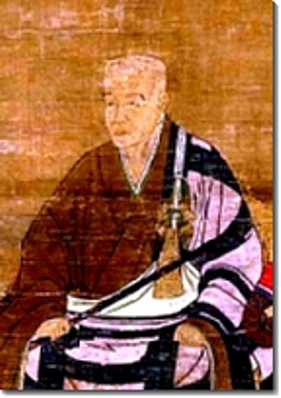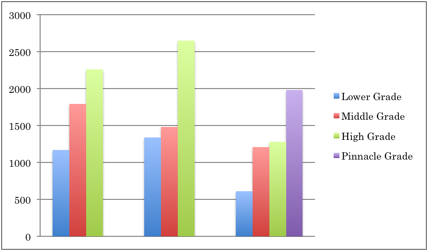 If we go back to the beginning of green tea, it may be interesting to know that green tea was not considered to be just a beverage, or even a “beverage” at all for that matter. It was a medicine. When Eisai (1141-1215. A Zen Buddhist Monk who brought the Rinzai School of Zen Buddhism to Japan after studying in China and India) brought home new teachings from his study in China and India, he also brought tea and knowledge of new ways of producing tea back with him. The records show, that the tealeaves were ground into a powder, and you mixed it in with hot water as if you were making Matcha. If you ate something bad and got food poisoning, or say you got a cold, ground tealeaves are what were prescribed. If a cut got infected, the answer was also tealeaves to be put on the cut. But as an interesting historical fact, the first recorded use of green tea as a medication in Japan, was not to cure a fatal illness, but was to treat a bad hangover.
If we go back to the beginning of green tea, it may be interesting to know that green tea was not considered to be just a beverage, or even a “beverage” at all for that matter. It was a medicine. When Eisai (1141-1215. A Zen Buddhist Monk who brought the Rinzai School of Zen Buddhism to Japan after studying in China and India) brought home new teachings from his study in China and India, he also brought tea and knowledge of new ways of producing tea back with him. The records show, that the tealeaves were ground into a powder, and you mixed it in with hot water as if you were making Matcha. If you ate something bad and got food poisoning, or say you got a cold, ground tealeaves are what were prescribed. If a cut got infected, the answer was also tealeaves to be put on the cut. But as an interesting historical fact, the first recorded use of green tea as a medication in Japan, was not to cure a fatal illness, but was to treat a bad hangover.
When the Shogun, Minamoto no Sanetomo (1192 -1219) complained of a bad hangover, Eisai, had him drink some tea. It is said that the Shogun rapidly recovered, and this story was recorded in the “Azuma Kagami”, the book of history of the Kamakura Era (recording history from 1180 to 1260)
Tea was considered to be an elixir that strengthened the internal organs, and was a source of longevity.
Due to years of research, today we know that green tea is a good source of Vitamin C, and the catechins (otherwise known as “the stuff that adds the sharp bitterness to the tea”, or epigallocatechin-3-gallate (EGCG)) contained in Sencha and other green teas are potent antioxidants. The antioxidants go after free radicals that could damage the DNA and contribute to cancer, atherosclerosis, and or blood clots. Catechin is also known to increase your memory, and fights bacteria. There are also studies that say that green tea may help lower “bad” cholesterol, keep your blood pressure from going too high, may help prevent strokes, heart attacks, and other heart disease.
Research on potential therapeutic uses of epigallocatechin-3-gallate (EGCG) include, but are not limited to HIV (not to cure or block HIV, but to help regulate the viral load), Cancer, Chronic Fatigue syndrome, Sjögren’s syndrome, Endometriosis, Spinal muscular atrophy, Neurodegeneration, Periapical lesions, and Cannabinoid 1 receptor, CB1 receptor Activity.
Naturally, more research is necessary to be able to say what exactly green tea does, especially considering that most of the modern day studies on green tea done up to now have been limited to the lab. However considering that tea has been treated a medicine (with a known track record) for over 1000 years, one can safely assume that there is something about green tea that is good for you.
This all sounds like a bunch of hype, but what it boils down to is this. While there are many interesting studies saying that 2 cups of green tea a day can considerably inhibit the growth of cancer, help you loose weight, and do all kinds of good stuff to your body, there are no studies to say that drinking 2 cups of green tea a day will do harm (*note 1).
And I think all tea lovers can agree that, considering the fact that tea is second only to water as an ideal beverage choice for body hydration, 2 cups of green tea a day, is a sugar free, delicious, and healthy habit, even if it is nothing else!
Note: Although there are many benefits, women who are in their first trimester of pregnancy, or are trying to get pregnant are told to avoid consuming large amounts of green based on some studies that point to the fact that too much EGCG may prevent your body to absorb folic acid, a very important B-vitamin critical to a baby’s development in the beginning stages of pregnancy.. Like anything, moderation is the key. If you are pregnant, it may be smart to limit yourself to 1 or 2 cups a day.
What Japanese Tea is “made of”:
Theanine: Theanine is an important amino acid found in green tea, and surprisingly, tea plants are the only plants to produce theanine. Theanine is responsible for the flavor and aroma of the tea, and it is what causes the calming effect of the tea. Theanine also tempers the effect of caffeine, which is why although green tea has caffeine, your body does not react to it as much. The calming effect of Theanine is also said to increase your alpha brain wave activity after 40 min of drinking green tea, allowing you to focus more, and be more productive.
The amount of Theanine in Japanese tea (mg/100g). From the left, Matcha, Gyokuro, and then Sencha.
Tannin (Catechin): Tannin is the source of the bitterness, or the astringency of Japanese tea. Also known as epigallocatechin-3-gallate (EGCG), it is what fights bacteria, lowers cholesterol, and is said to even fight cancer.
Vitamin C: Sencha, which is grown under the sun, is a goldmine for vitamin C, which is readily soluble in hot water. One note here, is the hot water used for brewing tea does not reduce the potency of the Vitamin C found in green tea.
Other vitamins: Green tea also contains other various vitamins too, such as A, D, E, B, B5, H, and K.
Caffeine: Caffeine is also one of the sources of bitterness in Japanese tea. Matcha and Gyokuro have a relatively high amount of caffeine, and Houjicha has the lowest.
Proteins: The teas flavor comes from the proteins included in the tealeaves. Matcha and Gyokuro, which are both made in the shade, have a higher protein value compared to Sencha.
Fat, Carbohydrates, Ash, and Fiber: Although these components are not a dominating factor in Japanese tea, small amounts are found in the tealeaves, and are soluble in hot water.
Other Minerals: Green tea contains various minerals. It is a rich source of manganese, and also contains other beneficial minerals such as Zinc, Chromium, Selenium, Calcium, and Potassium.









